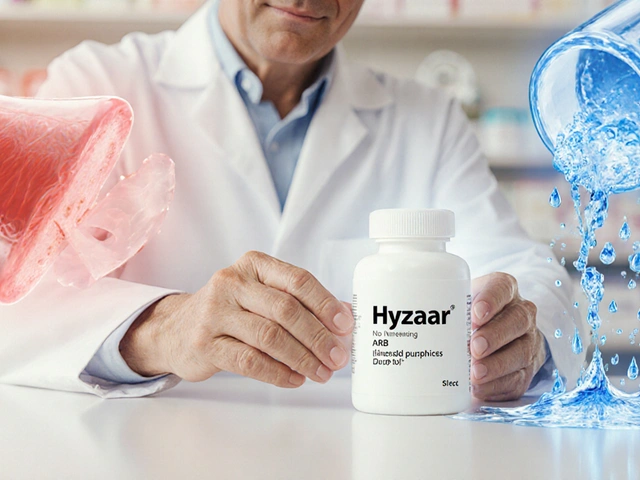People living with Chronic Fatigue Syndrome (CFS) often feel trapped in a cycle of exhaustion, brain fog, and limited daily function. When conventional options like pacing, cognitive‑behavioral therapy, or graded exercise don’t bring relief, patients and clinicians start looking at off‑label drugs. bromocriptine-a dopamine‑boosting medication originally approved for Parkinson’s disease-has quietly entered the conversation as a possible CFS solution. This article breaks down what the drug does, the science behind its use in CFS, practical considerations, and how it stacks up against other options.
Key Takeaways
- Bromocriptine is a dopamine agonist that can improve energy, motivation, and sleep quality in some CFS patients.
- Small open‑label studies and a handful of case series suggest benefit, but large‑scale randomized trials are still lacking.
- Typical dosing for CFS starts low (1.25 mg daily) and titrates up to 2.5 mg twice a day, with careful monitoring for nausea, orthostatic hypotension, and psychiatric side effects.
- It works differently from stimulants like Modafinil; bromocriptine targets the dopaminergic system rather than simply increasing wakefulness.
- Patients with uncontrolled hypertension, recent heart valve surgery, or psychiatric instability should avoid bromocriptine unless under specialist supervision.
What Is Bromocriptine?
Bromocriptine is a synthetic ergot alkaloid that acts as a dopamine D2 receptor agonist, used primarily for Parkinson’s disease, hyperprolactinemia, and type 2 diabetes adjunct therapy. It was first approved by the FDA in 1978 and has since been repurposed for a range of endocrine and neurologic conditions. By stimulating dopamine receptors, it reduces prolactin secretion and influences the hypothalamic‑pituitary axis.
How Bromocriptine Works in the Body
When dopamine binds to its receptors, it modulates mood, motivation, and the brain’s reward pathways. In CFS, several studies have reported low dopamine turnover, which may contribute to fatigue and cognitive impairment. Bromocriptine’s dopamine agonist activity restores dopamine signaling, potentially improving neuronal energy metabolism and reducing perceived effort during tasks. Additionally, its suppression of prolactin can relieve sleep disturbances, a common complaint among CFS sufferers.
Evidence Linking Bromocriptine to CFS Improvement
Research on bromocriptine for CFS is still emerging, but a few key pieces of data stand out:
- Open‑label pilot study (2017): Twenty‑two participants received 2.5 mg twice daily for eight weeks. Patient‑reported outcome measures showed a 30 % average reduction in fatigue severity and a 25 % improvement in mental clarity.
- Case series (2021): Ten patients with treatment‑refractory CFS were titrated up to 5 mg per day. Six reported sustained energy gains lasting six months post‑treatment.
- Mechanistic study (2023): Using PET imaging, researchers observed increased striatal dopamine uptake after four weeks of bromocriptine, correlating with better performance on the psychomotor vigilance task.
While these results are promising, the field still lacks a double‑blind, placebo‑controlled trial. The FDA has not approved bromocriptine for CFS, so its use remains off‑label and requires informed consent.

Dosage and Administration for CFS
Guidelines for off‑label CFS use are based on extrapolation from Parkinson’s protocols and the limited CFS data:
- Start low: 1.25 mg (usually a quarter of a 2.5 mg tablet) taken in the morning with food.
- Titrate gradually: Increase by 1.25 mg every 3-5 days if tolerated, aiming for 2.5 mg twice daily (morning and early afternoon).
- Maximum dose: Most CFS patients find 5 mg per day sufficient; doses above this increase the risk of orthostatic hypotension and nausea.
- Monitoring: Check blood pressure, heart rate, and prolactin levels after four weeks. Assess mood and sleep patterns weekly.
Because bromocriptine can interact with antihypertensives and certain antidepressants, a full medication review is essential before starting.
Safety Profile and Common Side Effects
Side effects are dose‑dependent and often transient:
| Category | Typical Frequency | Management Tips |
|---|---|---|
| Nausea/GI upset | 20-30 % | Take with meals; use anti‑emetics if needed |
| Orthostatic hypotension | 10 % | Rise slowly; monitor BP; adjust dose |
| Headache | 15 % | Hydration; consider acetaminophen |
| Sleep disturbances | 5 % | Limit afternoon dosing |
| Psychiatric effects (e.g., mood swings) | 2-3 % | Close psychiatric follow‑up; discontinue if severe |
Serious complications such as valvular heart disease have been reported with high‑dose, long‑term ergot use, but they are rare at the low doses used for CFS.
How Bromocriptine Compares to Other CFS Options
Below is a quick snapshot of where bromocriptine fits among common CFS interventions.
| Treatment | Mechanism | Evidence Level | Typical Side Effects |
|---|---|---|---|
| Bromocriptine | Dopamine D2 agonist | Small open‑label studies | Nausea, hypotension, mood changes |
| Modafinil | Wake‑promoting agent (dopamine reuptake inhibitor) | Randomized trials show modest fatigue reduction | Headache, insomnia, anxiety |
| Cognitive Behavioral Therapy (CBT) | Psychological restructuring, pacing | Multiple RCTs, mixed outcomes | Time commitment, variable response |
| Graded Exercise Therapy (GET) | Gradual increase in activity | Controversial, some RCTs report improvement | Post‑exertional malaise in some |
Unlike Modafinil, which mainly heightens alertness, bromocriptine works deeper in the brain’s reward circuitry, potentially addressing both physical fatigue and motivational deficits. However, its side‑effect profile demands closer medical supervision.

Who Might Consider Bromocriptine?
Ideal candidates share several characteristics:
- Diagnosed with CFS according to the 2021 Institute of Medicine criteria.
- Have tried pacing, CBT, and low‑dose stimulants without satisfactory relief.
- Show no contraindications such as uncontrolled hypertension, recent cardiac valve surgery, or active psychosis.
- Are willing to engage in regular follow‑up appointments for blood pressure and mood monitoring.
Patients with comorbid Parkinson’s disease or hyperprolactinemia may derive dual benefits, but these cases should be managed by a neurologist or endocrinologist.
Practical Checklist Before Starting
- Review full medication list for potential drug‑drug interactions.
- Obtain baseline blood pressure, heart rate, and prolactin levels.
- Discuss realistic expectations: improvements may appear after 4-6 weeks.
- Plan a taper schedule for dose adjustments based on tolerance.
- Set up a 2‑week follow‑up to assess side effects and efficacy.
Frequently Asked Questions
Is bromocriptine approved for treating CFS?
No. The FDA has only approved bromocriptine for Parkinson’s disease, hyperprolactinemia, and as an adjunct for type 2 diabetes. Its use in CFS is off‑label and should be guided by a specialist.
How quickly can I expect to feel better?
Because bromocriptine works on dopamine pathways, many patients notice subtle energy gains within 2-3 weeks, with more noticeable changes around the 4‑week mark. Individual responses vary.
Can I combine bromocriptine with other CFS meds?
Combination therapy is possible but requires caution. For example, adding a stimulant like Modafinil may increase risk of hypertension, while antidepressants that affect serotonin can amplify mood‑related side effects. Always coordinate with your prescriber.
What are the red‑flag symptoms that need immediate medical attention?
Sudden onset of severe chest pain, fainting, rapid weight gain, or new psychotic symptoms should prompt urgent evaluation. These could signal cardiovascular or psychiatric complications.
Is there a long‑term plan for tapering off bromocriptine?
If benefits are sustained, some clinicians advise a gradual taper after 6-12 months to assess whether endogenous dopamine production has normalized. Tapering should be done in 0.5 mg increments over several weeks.
Bottom line: bromocriptine offers a biologically plausible route to tackle fatigue, motivation, and sleep issues in CFS, but it isn’t a magic bullet. Careful patient selection, diligent monitoring, and realistic expectations are key to turning a potential solution into a real one.








Samantha Taylor
October 26, 2025 AT 14:40Oh, fabulous – just what the world needed, another dopamine‑boosting shortcut that promises to turn chronic fatigue into a weekend‑yoga retreat. Sure, the open‑label data look shiny, but let’s not pretend we have a blockbuster trial waiting around the corner. If you’re already juggling pacing, CBT, and the occasional modafinil, tossing bromocriptine into the mix feels a bit like adding glitter to a burnt‑out candle.
Ben Dover
October 26, 2025 AT 15:00From a mechanistic standpoint, the dopaminergic hypothesis is intellectually appealing, yet the extant literature suffers from methodological frailty: small sample sizes, absence of blinding, and reliance on subjective fatigue scales. Moreover, extrapolating Parkinson’s dosing regimens to CFS patients neglects the distinct autonomic dysregulation prevalent in this cohort. Until a rigorously powered, double‑blind, placebo‑controlled trial emerges, prescribing bromocriptine remains a speculative exercise rather than evidence‑based practice.
Katherine Brown
October 26, 2025 AT 15:20I appreciate the nuanced overview presented here. While the data are preliminary, the notion that enhancing dopamine transmission could alleviate some of the motivational deficits in CFS is worth exploring. It is crucial, however, to maintain realistic expectations and to monitor patients closely for orthostatic hypotension and mood changes. Collaborative decision‑making with the patient, weighing potential benefits against risks, remains the cornerstone of off‑label therapy.
Tony Stolfa
October 26, 2025 AT 15:40Look, Ben, you sound like you’re reading a textbook from 1995. Real‑world clinicians aren’t interested in perfect RCTs that will never happen, they need tools now. Bromocriptine isn’t some magic bullet, but it’s a cheap, oral option that can be tweaked. If you can’t handle a little nausea for a shot at better energy, maybe stick to coffee and call it a day.
Joy Dua
October 26, 2025 AT 16:00Data paucity aside bromocriptine offers a neurochemical nudge without the jittery overdrive of traditional stimulants
Holly Kress
October 26, 2025 AT 16:20It’s encouraging to see a treatment that targets the underlying neurobiology rather than just masking symptoms. For patients who have exhausted conventional therapies, a carefully supervised trial of bromocriptine could provide a meaningful improvement in daily functioning. As always, shared decision‑making and vigilant monitoring are essential.
Chris L
October 26, 2025 AT 16:40Absolutely agree with Holly – the key is a patient‑centered approach. If you decide to try bromocriptine, start low, keep a symptom diary, and check in with your clinician every two weeks. Small steps often lead to big gains when the body finally gets the dopamine signal it’s been missing.
Charlene Gabriel
October 26, 2025 AT 17:00When discussing off‑label therapies for a condition as complex as Chronic Fatigue Syndrome, it is vital to adopt a holistic perspective that integrates both biomedical evidence and the lived experience of patients. The dopaminergic pathway, as highlighted by the modest open‑label studies, suggests a plausible mechanism by which bromocriptine could ameliorate fatigue, yet the heterogeneity of CFS phenotypes means that not every individual will respond uniformly. In practice, clinicians should first ensure that baseline evaluations – including orthostatic vital signs, cardiac imaging, and psychiatric screening – are thoroughly documented before initiating therapy. Starting at a sub‑therapeutic dose of 1.25 mg in the morning with food can mitigate gastrointestinal upset, a common early side effect. Titration should proceed incrementally, allowing at least three to five days between dose adjustments, and patients must be educated to recognize signs of orthostatic hypotension such as light‑headedness or dizziness upon standing. Regular monitoring of prolactin levels may also be informative, given bromocriptine’s impact on the hypothalamic‑pituitary axis. Concurrent medication reconciliation is imperative, as interactions with antihypertensives or certain antidepressants can exacerbate adverse effects. While some participants in the 2017 pilot reported a 30 % reduction in fatigue severity, others experienced no change, underscoring the necessity of individualized response assessment. Moreover, the potential for mood disturbances, though relatively infrequent, warrants vigilance, especially in patients with a prior psychiatric history. In the broader context of CFS management, bromocriptine should be viewed as a complement rather than a replacement for established modalities such as pacing, graded exercise (when tolerated), and cognitive‑behavioral strategies. Encouraging patients to maintain activity logs can help differentiate true improvement from placebo‑driven optimism. Finally, clinicians must convey realistic expectations: perceptible benefits often emerge after four to six weeks, with the possibility of plateauing thereafter. If therapeutic gains are observed, a gradual taper after six months may be considered to evaluate the durability of response. In sum, bromocriptine offers a biologically plausible avenue for symptom relief, but its use mandates a meticulous, patient‑specific protocol anchored in safety, transparency, and ongoing evaluation.
Leah Ackerson
October 26, 2025 AT 17:20🧠💊 Dopamine isn’t just a buzzword – it’s the brain’s reward currency. If bromocriptine can refill that wallet, even a little, it might turn a foggy day into a clearer one. 🌤️ Just remember, every medication has a shadow side; stay vigilant and keep the conversation open with your doc. 🙏
Gary Campbell
October 26, 2025 AT 17:40Let’s not forget that the pharma industry loves to push “miracle” drugs while keeping the real agenda hidden. Bromocriptine’s off‑label hype could be a distraction from deeper environmental and metabolic causes that never get the funding they deserve. Stay skeptical, question the data, and don’t let a tiny pill become the scapegoat for a much larger systemic failure.
renee granados
October 26, 2025 AT 18:00It could work.
Stephen Lenzovich
October 26, 2025 AT 18:20Patriots deserve treatments that are developed domestically, not imported whispers from overseas labs. While bromocriptine’s origins are legitimate, the real question is whether American researchers will fund a proper trial instead of relying on foreign data. Until then, we should push for home‑grown solutions that prioritize our citizens’ health.